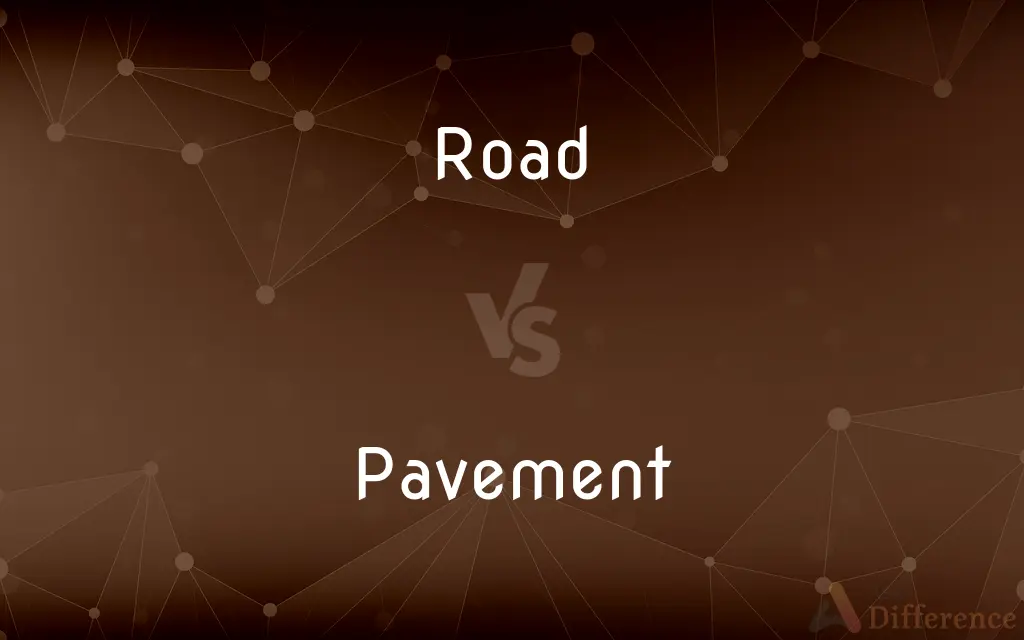Road vs. Pavement — What's the Difference?
Edited by Tayyaba Rehman — By Urooj Arif — Updated on February 26, 2024
A road is a wide path designed for vehicles to travel between destinations, while pavement refers to the surface layer of a road or sidewalk intended for pedestrian use.

Difference Between Road and Pavement
Table of Contents
ADVERTISEMENT
Key Differences
Roads are thoroughfares that facilitate the movement of vehicles, bicycles, and pedestrians between different places, typically made of asphalt, concrete, or gravel. They are an essential part of transportation infrastructure, connecting cities, towns, and rural areas. Pavements, on the other hand, specifically denote the hard surface layer of roads or the sidewalks beside them, primarily designed for pedestrian use. In some regions, "pavement" is synonymous with "sidewalk," highlighting its role as a pedestrian pathway.
The construction of roads involves multiple layers, including subgrade, base, and surface layers, to ensure durability and support for heavy vehicles. Pavement, in contrast, focuses on the surface layer, which can be made of materials like concrete, asphalt, or paving stones, providing a smooth and durable surface for walking or driving.
Roads serve a broader purpose in transportation systems, accommodating various types of vehicles and, at times, pedestrians, pavements are dedicated to ensuring safe pedestrian spaces. This distinction emphasizes the different design and safety considerations for each, with pavements often featuring elements like curbs, benches, and lighting for pedestrian comfort and safety.
The terminology used to describe these features can vary by region. In American English, "pavement" often refers to the road surface itself, whereas in British English, it more commonly means the sidewalk. This difference in usage underscores the importance of context when discussing roads and pavements across different English-speaking countries.
Roads and pavements are integral to urban and rural infrastructure, each serving distinct but complementary roles. Roads facilitate the broader movement of people and goods, while pavements focus on pedestrian access and safety, reflecting the diverse needs of a mobile society.
ADVERTISEMENT
Comparison Chart
Definition
A wide path made for vehicles, connecting different locations.
The surface layer of a road or a sidewalk designed for pedestrian use.
Purpose
Facilitates vehicle, bicycle, and pedestrian movement.
Provides a safe and durable surface for pedestrians.
Construction
Includes multiple layers: subgrade, base, and surface.
Focuses on the top layer, often made of concrete, asphalt, or stones.
Usage
Serves a broad transportation network.
Dedicated to pedestrian safety and comfort.
Regional Terminology
Universally recognized as a vehicle pathway.
Meaning varies: refers to the road surface in the US and sidewalks in the UK.
Compare with Definitions
Road
Varies in size and design.
Rural roads are often narrower than urban ones.
Pavement
Made from concrete, asphalt, or paving stones.
The pavement outside the shop was laid with decorative stones.
Road
Can be made from various materials.
The road was paved with asphalt for smoother travel.
Pavement
Can be part of the road structure.
Road maintenance includes repairing the pavement.
Road
Essential for transportation infrastructure.
Roads facilitate efficient travel and commerce.
Pavement
A paved path, for the use of pedestrians, located at the side of a road.
Road
A pathway for vehicles and pedestrians.
The new road connects two major cities.
Pavement
A hard surface layer for walking.
The pavement was redesigned for better pedestrian access.
Road
Built with multiple layers for durability.
Road construction requires careful planning and layering.
Pavement
Often refers to sidewalks in certain regions.
The new pavement along Main Street has improved pedestrian safety.
Road
A road is a wide way leading from one place to another, especially one with a specially prepared surface which vehicles can use. Roads consist of one or two roadways (British English: carriageways), each with one or more lanes and any associated sidewalks (British English: pavement) and road verges.
Pavement
Designed for pedestrian comfort and safety.
The city added benches and lighting to the pavement.
Road
A way used for travelling between places, originally one wide enough to allow foot passengers and horses to travel, now (US) usually one surfaced with asphalt or concrete and designed to accommodate many vehicles travelling in both directions. In the UK both senses are heard: a country road is the same as a country lane.
Pavement
A hard smooth surface, especially of a public area or thoroughfare, that will bear travel.
Road
(uncountable) Roads in general as a means of travel, especially by motor vehicle.
We travelled to the seaside by road.
Pavement
A paved surface; a hard covering on the ground.
Road
A place where one may ride; an open way or public passage for vehicles, persons, and animals; a track for travel, forming a means of communication between one city, town, or place, and another.
The most villainous house in all the London road.
Pavement
A paving (paved part) of a road or other thoroughfare; the roadway or road surface.
Road
Taking place over public roads;
Road racing
Pavement
The paved part of an area other than a road or sidewalk, such as a cobblestone plaza, asphalt schoolyard or playground, or parking lot.
Pavement
Walk consisting of a paved area for pedestrians; usually beside a street or roadway
Common Curiosities
How does the construction of roads and pavements differ?
Roads are constructed with multiple layers for durability, while pavements focus on the surface layer for pedestrian use.
What materials are commonly used for roads and pavements?
Roads and pavements can be made from asphalt, concrete, or paving stones.
Why is the choice of material important for pavement construction?
Material choice affects durability, safety, and maintenance needs.
Can pavement refer to both a road's surface and a sidewalk?
Yes, the term varies regionally, referring to the road surface in the US and sidewalks in the UK.
Are pavements necessary in all road designs?
Not all roads have pavements, especially in rural areas, but they are crucial in urban settings for pedestrian safety.
How do weather conditions impact road and pavement maintenance?
Weather can cause wear and damage, requiring regular maintenance to ensure safety and durability.
What's the main difference between a road and pavement?
Roads facilitate vehicle movement, while pavements are designed for pedestrian use.
How do pavements contribute to pedestrian safety?
They provide a designated, safe area for pedestrians away from vehicular traffic.
Can the design of a pavement affect pedestrian traffic?
Yes, design elements like width, surface texture, and accessibility features can influence pedestrian flow and safety.
Do roads always include pavements?
Not always; it depends on the road's location and intended use.
Are there environmental considerations in road and pavement construction?
Yes, sustainable materials and construction methods are increasingly used to minimize environmental impact.
How do urban and rural roads differ in terms of pavement presence?
Urban roads typically include pavements for pedestrian safety, while rural roads may not.
What role do curbs play in pavement design?
Curbs separate the pavement from the road, enhancing pedestrian safety.
Is the term "sidewalk" synonymous with pavement everywhere?
No, "sidewalk" is primarily an American term, while "pavement" is used in the UK.
What advancements have been made in pavement technology?
Developments include more durable materials and designs that improve pedestrian comfort and reduce maintenance needs.
Share Your Discovery

Previous Comparison
Usage vs. Custom
Next Comparison
Drum vs. RuffleAuthor Spotlight
Written by
Urooj ArifUrooj is a skilled content writer at Ask Difference, known for her exceptional ability to simplify complex topics into engaging and informative content. With a passion for research and a flair for clear, concise writing, she consistently delivers articles that resonate with our diverse audience.
Edited by
Tayyaba RehmanTayyaba Rehman is a distinguished writer, currently serving as a primary contributor to askdifference.com. As a researcher in semantics and etymology, Tayyaba's passion for the complexity of languages and their distinctions has found a perfect home on the platform. Tayyaba delves into the intricacies of language, distinguishing between commonly confused words and phrases, thereby providing clarity for readers worldwide.
















































